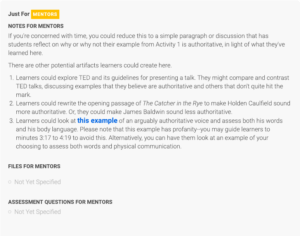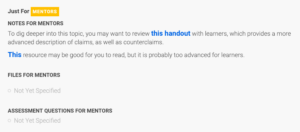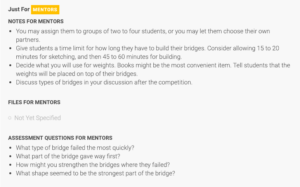Duly Noted: Supporting Mentors and Students Through Quest Design
By: Karen Tavenner Acosta, Emily Russin, and Jeff Osbourne
Students who complete quests, and the mentors who support them, depend on quest designers to provide tools that assist learning and track progress. Quest designers develop tools for mentors to customize learning, make modifications, and easily assess student achievement. In order to do so, however, quest designers need to build in notes for mentors so they can help students be accountable to their mentors, their peers, and to themselves.
The “Just for Mentors” sections in quest activities (which include “Notes for Mentors,” “Files for Mentors,” and “Assessment Questions”) are useful tools that quest designers should incorporate when creating quests. Mentors can use these sections while guiding students so that students can overcome challenges, modify activities, and evaluate their work and that of their peers. When students become accountable in these ways, mentors are better able to support them through quests; they can track student progress and intervene if students get stuck on a particular task.
As an example, the US quest Fourteen Pointless? explores the driving question, “What is the best way to maintain world peace?” Through this lens, students investigate how the US deployed its power in World War I. Mentors receive assessment questions, such as: “Do you think World War I could have been avoided?; If you were alive in 1917, would you have supported entering the war?; Do you think that the Allies would still have won without US help?” All questions are followed by, “Why or why not?” Students learn information, concepts, and skills, and the mentor assessment questions help them reflect critically on the quest’s activities as they are completed. When students engage with these questions, they begin to understand they are responsible for more than mere memorization or absorbing of information. Because of how these assessment questions are incorporated throughout quests, students can apply what they learn to other contexts, with guidance from their mentors.
Mentor assessment questions push students further, and help them make sense of a quest’s experiences. Artifacts are yet another way in which these questions help students approach understanding within a quest. Through artifacts, students not only assimilate the quest’s basic requirements and expectations, but they also receive their mentor’s guidance through completion of the artifact. Well-designed artifacts give students a clear sense of their responsibilities, and well-designed “Just for Mentors” sections support mentors as they oversee the process. Additionally, when students know their work will be shared, discussed, reviewed, challenged and/or evaluated, they are more likely to have accountability for their artifacts. During check-ins (formal and informal), mentors are able to assess students’ progress through quests more capably, particularly in conjunction with assessment questions.
Between the Notes for Mentors and assessment questions in QuestMaker™, designers can more helpfully structure mentor engagement with students. Mentors and their students can better evaluate student progress and encourage student accountability. Students will greatly benefit from the work of their mentors and the quest designers who built the mentorship opportunities. Through their interactions with mentors and an increasing awareness of their responsibilities for reflection, check-ins, and answering assessment questions, students make clear progress through quests, and are able to utilize their knowledge and skills going forward.
Below are additional examples of how the “Just for Mentors” section can be used to support mentors through quest design:
1. Suggesting modifications to an activity with an artifact, from the quest I’m the Authority!:

2. Providing extra materials for both students and mentors, from the quest It’s Time for an Academic Argument (Part 1):

3. Providing procedural guidance for an activity, from the quest History of Bridges and Truss Bridge Design:

